pYrana13
Junior Member level 1
Hi all,
In Class-D amplifier, the transistors are in Push-Pull configuration. To drive the transistors using the PWM signal, the signal given at either transistor is inverted of the other signal.
The question is:
From most of the references I read, why they normally used 180 degree phase shift?? If PWM phase is shifted, it is not exactly inverted. Thus both signals which drive the transistors are not inverted to each other, but only delay.
Could somebody explain this to me. TQ.
In Class-D amplifier, the transistors are in Push-Pull configuration. To drive the transistors using the PWM signal, the signal given at either transistor is inverted of the other signal.
The question is:
From most of the references I read, why they normally used 180 degree phase shift?? If PWM phase is shifted, it is not exactly inverted. Thus both signals which drive the transistors are not inverted to each other, but only delay.
Could somebody explain this to me. TQ.



